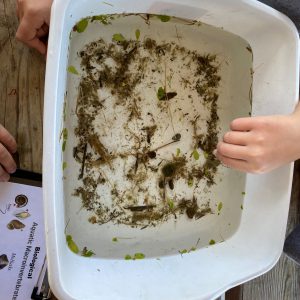In today’s world, it is more important than ever to provide opportunities for youth to experience the natural world.
Each year, local 4th and 5th grade students participate in Learning in Florida’s Environment (L.I.F.E.) to explore topics related to the natural sciences and learn about future career paths, all while enjoying a morning at one of our beautiful County and State Parks. L.I.F.E. is an environmental education program coordinated by UF/IFAS Extension Sarasota County in partnership with Florida State Parks, Sarasota County Parks, and Sarasota County Schools. This year students participated in a Water Quality and Biodiversity Lab at Lake Osprey in Oscar Scherer State Park.
Starting With the Basics
Prior to the field trip, an initi al lesson was held in the classroom where children were introduced to concepts including biodiversity, water quality, and the types of equipment they would soon be using. The field lab took place at Lake Osprey in Oscar Scherer State Park. The lab began with exploring water quality by measuring pH, temperature, and dissolved oxygen concentration of a water sample collected from the lake. Students were given the opportunity to analyze the water using a variety of field instruments, and would participate in a class discussion about the importance of each water quality parameter.
al lesson was held in the classroom where children were introduced to concepts including biodiversity, water quality, and the types of equipment they would soon be using. The field lab took place at Lake Osprey in Oscar Scherer State Park. The lab began with exploring water quality by measuring pH, temperature, and dissolved oxygen concentration of a water sample collected from the lake. Students were given the opportunity to analyze the water using a variety of field instruments, and would participate in a class discussion about the importance of each water quality parameter.
Connecting Concepts
After each parameter was measured, students were asked to use what they learned about water quality to develop a hypothesis about the level of biodiversity they might observe in Lake Osprey. All student groups demonstrated the ability to develop a logical hypothesis using what they learned about pH, temperature, and dissolved oxygen. Upon completion of the water quality analysis, the students were presented with plastic bins containing live macroinvertebrates that were collected by dipnet from the lake prior to the lesson. Students worked in groups to carefully examined the contents of the bins, counting the different types of macroinvertebrates and recording their findings. All student groups asserted that their hypotheses were correct, demonstrating that the students were able to use critical thinking to connect the concepts of water quality and biodiversity.
This lab captured the attention and imagination of students by providing new and novel experiences. The ability to learn about, see, and use scientific field equipment introduced young participants to instruments commonly used in many technical careers. Most of all, the children were always eager to peak inside the plastic bins to see what tiny creatures were swimming about in the lake.
For Teachers
Learn more about this program and others like it:
- L.I.F.E. Coordinator: Dr. Katherine Clements, Ecology and Natural Resources Educator – kclements@scgov.net
- Water Resources: Michael D’Imperio, Water Resources Agent – mdimperio@ufl.edu
- 4-H and Youth Development: Sarah Davis, 4-H Youth Development Agent – sarahdavis@ufl.edu
 0
0
